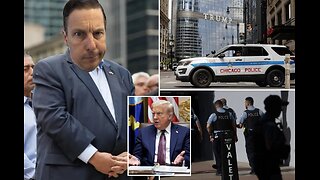Premium Only Content

The 5 Stans = NWO
Cause Before Symptom - With Your Host James Carner
The 5 Stans = NWO
It’s election week and I wanted to show you Trump, who just performed this lude act at one of his rallies. This is a Christian?
Play 1.
The 5 Stans = NWO Headquarters After WWIII
The 5 Stans are the legacy of the old USSR. Kazakhstan, Kyrgyzstan, Tajikistan, Turkmenistan and Uzbekistan.
Prnounced: kaa zuhk staan, keer guh staan, taa jee kuh staan, trk meh nuh staan and ooz beh kuh stan
Play Rotation
In Turkmenistan, the city Ashgabat was known as the “garden city” before the Bolshevik revolution. It was drowned in greenery, canals gurgled with mountain water and trees cast a shady cool even in July and August. In the evenings, neighbours would gather around gazebos and drink tea. It was paradise.
After Turkmenistan gained independence from the Soviet Union in 1991, Ashgabat experienced a second birth. Today, modern Ashgabat is jokingly called the “city of the dead”, because it is almost impossible to see people in the new districts of white marble. The city holds the Guinness Book of Records title for most white marble on Earth. It holds several records, in fact: the world’s largest enclosed observation wheel, the largest fountain, the largest mural of a star. The new airport has the world’s largest image of a Turkmen carpet, adorning the main passenger terminal. Until recently, the capital even boasted the world’s tallest flagstaff. All of these new toys, these buildings, parks and roads, were supposedly built for the people. They paid for it with their silence.
The President Saparmurat Niyazov had begun to introduce the idea of his own superiority into society, and began to rebuild Ashgabat in his own way. Dozens of historical monuments were destroyed and hundreds of houses demolished. In their place, high-rise buildings were built, faced with white marble. Almost all the perennial trees were cut down, replaced by coniferous trees unsuited to a dry climate and giving little shadow. New highways were laid, and the irrigation system of canals, which created the city’s special microclimate, was almost completely destroyed. In place of the old tea spots are car parks or outright wastelands.
As the Russian-speaking population began to leave the country in droves, a campaign began to eradicate the language. Non-Turkmen employees were fired, and universities stopped accepting students with non-Turkmen names. Many of my friends and classmates did not wait for graduation and simply left the country.
An attempt on Niyazov’s life in November 2002, and the subsequent wave of arrests of anyone critical of the authorities, it was impossible for anyone to leave this dictatorship country. The ascension to power of Gurbanguly Berdimuhamedov the year following Niyazov’s death began a new wave of destruction in the city. Berdimuhamedov immediately set his sights on eradicating his predecessor’s memory. He initiated “reconstruction” of the central avenue, named after Niyazov, meaning it was entirely torn up. He built his new palace there, demolishing dozens of houses for the purpose, and blocked an entire street to the public, turning it into his personal boulevard. Along any central street through which the president might pass, it is forbidden to open windows, install air conditioners or satellite dishes and hang clothes.
The authorities invested in developed infrastructure, but not in qualified specialists: as a result, in the hot summer months, some neighbourhoods languish for days without water and electricity, while in the centre of the city fountains flow around the clock and lights burn brightly for no one. Across Ashgabat, the authorities seemed to take a special pleasure in destroying centuries-old trees, which in their opinion prevent the expansion of roads.
Among the pompous facilities in which they invested billions of dollars, the airport stands out – and that’s in a city which also built an international bus terminal that, for the first five years of its existence, has not served a single international route. The airport, meanwhile, cost $2.3bn and is designed to serve 1,600 passengers per hour, but operates at 10% of capacity. To build this new airport, a whole village, Choganly, was demolished. Amnesty International has counted about 10,000 demolished buildings, home to roughly 50,000 people. The reason for the demolition? The president worried that foreigners would see the unattractive everyday life of ordinary Turkmen people from the windows of arriving planes.
Because the president dislikes animals, city authorities have killed stray dogs and even households pets in barbaric ways. Animal advocates who report these executions to foreign media are threatened with violence, deprived of internet access and have criminal cases fabricated against them.
The few activists and independent journalists who try to bring the real situation in Turkmenistan to the world are similarly harassed and intimidated. One striking example is a criminal case against independent journalist Saparmamed Nepeskuliyev, who was arrested in 2015 on false charges of possession of the illegal Tramadol drug. Nepeskuliyev reported for foreign media outlets – including Alternative Turkmenistan News and Radio Liberty – on the poor condition of roads in his native city, the lack of drinking water, and the problems in health care and education. The result was three years of imprisonment, and perhaps worse: his name was recently included on a list of people who have disappeared in Turkmen prisons, as none of his relatives know where he is or what condition he is.
Life goes on in my old city. Everyday people struggle to find work to support their families, in conditions of high unemployment and total corruption. According to independent estimates, unemployment in Turkmenistan has reached 60%. Yet the latest addition to the city? A $5bn international “Olympic village” built for the recent 10-day Asian Games.
Many residents remember with a bitter smile the documentary about Ashgabat by the Belgian journalist Tom Waes. Invited by the authorities to create a favourable image of the country abroad, Waes and his film crew came well prepared to be objective. They filmed the clumsy attempts of “civilian guides” to hide even the most innocuous evidence of everyday life: a messy shelf in the market; a shopkeeper’s thermos of tea; a dustpan and broom for cleaning. Everything is fine in our city, the guides were at pain to show. In Ashgabat, as in Baghdad, everything is calm.
When Stanislav Volkov began reporting for the Alternative Turkmenistan News, the secret service cut his internet and threw acid at him – all for daring to describe the harsh reality of daily life in this notoriously reclusive capital.
The National Council of Turkmenistan, now defunct, was Turkmenistan’s bicameral national legislative body or parliament from March 2021 until January 2023. The upper chamber was the People’s Council and the lower chamber was the Assembly. The National Council was created in March 2021 following election of members to the upper chamber, which in turn followed a constitutional amendment in late 2020.
In January 2023 both chambers of parliament proposed to abolish the People’s Council (Halk Maslahaty) as a legislative organ, to reform it as an independent body, and to place all legislative authority in a unicameral Assembly (Mejlis). The National Council was accordingly abolished by unanimous vote of its members in a joint session of the People’s Council and Assembly on 21 January 2023.
The Assembly is since January 2023 the unicameral legislature of Turkmenistan. Between March 2021 and 21 January 2023 it was the lower house of the National Council of Turkmenistan. It has 125 members, elected for five-year terms in single-seat constituencies.
The Constitution of Turkmenistan stipulates that the assembly:
Enacts laws, makes amendments and additions to the Constitution and laws, monitors their performance and their interpretation. Considers for approval the programme activities of the Cabinet of Ministers; Examines questions related to approval of the state budget of Turkmenistan and reports on its implementation.
Considers the basic directions and programmes of political, economic and social development of the country. Determines whether to hold national referendums. Declare the election of the President of Turkmenistan, deputies of the Mejlis, members of the velayat, district, municipal representative bodies and the Gengeshes.
Considers the recommendations of the President of Turkmenistan on the issues related to the appointment and dismissal of the Chairman of the Supreme Court, the Prosecutor General, the minister for Internal Affairs, the minister for Justice. Establishes state awards, awards state decorations to the President of Turkmenistan, assigns him the military ranks and distinctions.
Determines conformity to or divergence from the Constitution and the normative-legal Acts by the state authorities and government. Ratifies and denounces international treaties. Considers questions related to change of state borders and administrative and territorial division of Turkmenistan.
Examines the issues related to peace and security. Decides other questions in the competence of the Mejlis under the Constitution and laws. The Mejlis belongs to the OSCE Parliamentary Assembly and the Inter-Parliamentary Union.
The "Gates of Hell"
A flaming crater located about a four-hour drive north of Ashgabat, the "Gates of Hell" is a mystery as to how it first ignited. Some say it was set on fire by a hand grenade, a match thrown by the Soviets, or a drunk farmer driving his tractor into it. Darvaza gas crater, which is is called, is 230 feet wide that has been on fire for over 50 years. The gas crater is near the village of Darvaza in the middle of the Karakum Desert. Located about 260 kilometres (160 mi) north of Ashgabat, the capital of Turkmenistan, it has a diameter of 60–70 metres (200–230 ft) and a depth of about 30 metres (98 ft). Another nearby gas crater is fenced off and has a distinct odor.
The early years of the crater's history are still being determined. Relevant records are either absent from the archives, classified, or inaccessible. Some local geologists have claimed that the collapse of a crater happened in the 1960s; it was set on fire only in the 1980s to prevent the emission of poisonous gases. Others assert that the site was drilled by Soviet engineers in 1971 as an oil field but collapsed within days, forming the crater, with the engineers choosing to flare the crater to prevent the emission of poisonous gases but underestimating the volume of the gas.
In April 2010, President Gurbanguly Berdimuhamedow recommended that measures be taken to limit the crater's influence on the development of other natural gas fields in the area. In January 2022, Berdimuhamedow announced plans to extinguish the crater, citing deleterious effects on local health, the environment, and the natural gas industry. A commission was established to find the optimum technique. Despite Berdimuhamedow's intentions, the crater remains open and burning. In 2013, George Kourounis became the first person to set foot at the bottom of the crater; he was gathering soil samples for the Extreme Microbiome Project. The descent was sponsored by National Geographic and featured in an episode of the National Geographic Channel series Die Trying. Kourounis used a custom-made Kevlar harness and multiple Technora ropes attached to a full-body aluminized suit with a self-contained breathing apparatus. He has since wished to descend into the crater again, carrying more equipment for better profiling of the local biome.
Origin of this fire pit is considered top-secret to the Russian Government. The story goes that in 1971 Soviet geologists were drilling for oil in the desert when they hit a pocket of natural gas. This caused the earth to collapse, forming three large sinkholes. In order to prevent the methane from leaking into the atmosphere, it's rumoured that geologists lit one of them on fire, thinking it would burn out in a matter of weeks.
But after Canadian explorer George Kourounis set off on the first expedition to plumb the crater's depths in 2013, he discovered that no-one actually knows how this hellish inferno came to be. According to local Turkmen geologists, the gaping 69m-wide-by-30m-deep crater formed in the 1960s and wasn't lit until the 1980s. Yet, because gas and oil were highly prized commodities in Turkmenistan during Soviet rule, it appears any record of the crater's creation is now classified and top-secret information.
What is certain is that this unlikely methane-belching fire pit has become one of the most popular tourist attractions in a country that only sees about 6,000 visitors per year. For much of the past decade, as the sun dips below the Karakum's sea of sand dunes, wide-eyed wanderers from near and far have come to witness this blazing colosseum of fire light up the desert sky.
Putting tourism aside, in 2022 President Gurbanguly Berdymukhamedov ordered the Gates of Hell to be extinguished. He had abruptly given the same command in 2010, without stating any clear reasons, but it was never completed.
Turkmenistan has the 4th largest natural gas reserves in the world, as well as substantial oil reserves. Throw in a totalitarian government and you end up with large, oppulent cities that look like ghost towns.
There is little information about the city of Ashgabat and the gates of hell. Conspiracy theorists have no real evidence to stand on this strange country and the buildings. In my opinion, it looked like some religious sect were welcoming something and it never came or they built all of this for the vanity of a king who didn’t last long anyways.
Astana, Kazakhstan Headqurters
Of all places, why put a city here? From the airplane window it’s more of the same: flat, empty and endlessly vast. At 30,000 feet, a few lonely lakes polka-dot the landscape. There is no evidence of human activity at all. There are scarcely any trees and few distinguishing landmarks. On and on it goes – Kazakhstan is the size of western Europe, and so unremittingly flat, it’s as if some gigantic plasterer has skimmed the land. Here wolves outnumber people. Little wonder the Soviets chose this vast emptiness to hide their Gulags and their space programme, and to test their nuclear weapons. Much of it radioactive, it’s an agoraphobic’s vision of hell.
And then, out of nowhere, Astana comes glistening into view, all shiny metal and glass, implausibly rising up from the Kazakh steppe like some post-modern lego set that has stumbled into the opening sequence of Dallas. Welcome to Astana, one of the strangest capital cities on earth.
There was some early talk of Astana – which means “capital” in Kazakh – being named after the president, Nursultan Nazarbayev. After all, his name and vision are omnipresent. Since independence from the USSR in 1991, he was the first – and has been the only – president of the Republic of Kazakhstan, with an electoral victory earlier this year in which he received a comedy 97.7% of the vote.
All presidents are limited to a term of five years – except, of course, Nazarbayev, over whom the press has suspended any modicum of critical vigilance. Many Kazakh officials are quite open about it: they have chosen to do economic development first, and proper democracy (they hope) will come at some point later.
Given the billions of barrels of oil and gas that have been discovered in the country, and its very low population of only 16 million, every Kazakhstani should be a millionaire by now. One look at Astana and you can see where much of the money has gone: everywhere it’s big, flashy signature buildings, all wearing their architects’ names like fashion labels, all competing for attention like a collection of spoiled teenagers insecurely shouting: “Look at me!”
Take the Norman Foster-designed Khan Shatyr shopping centre, on the road into town from the airport. It’s the world’s largest marquee with total area of 127,000 sq metres and a height along the spire of 150 metres. A special chemical lining protects those inside from the brutal icy winter and helps it maintain its special microclimate. The artificial beach, with sand specially imported from the Maldives, requires a constant 35C. All shopping centres need a beach, of course.
For a centrally planned city, the aesthetic juxtapositions are remarkably discordant. A flashy glass pyramid. A towering set of apartments built to match Moscow University in the Stalinist empire style. A Disney version of the White House. A vase-like tower with a ball on top that the president apparently designed on the back of a napkin during a state dinner. A finance ministry shaped as a dollar bill.
Few of these buildings seem to have been designed with practicality in mind. The lifts in the pyramid go up, then left, then up, then left – it must have been incredibly expensive to get them to waltz like that. My hotel has an impressive light show on the outside of the building … and terrible Wi-Fi.
When the capital was moved here from Almaty in 1997, there was little enthusiasm among government officials who were forced to relocate. Almaty – which finds out this week if it has been successful in its bid to host the 2022 Winter Olympics – is more than a thousand kilometres further south, and is a much older and considerably classier affair. This is where Prince Harry enjoyed his winter holiday with Cressida Bonas in 2014, and where government officials spent long weekends cooking plov at their luxury dachas styled on English country houses.
The official reason for relocating to Astana – previously the provincial settlement of Tselinograd, with a crumbling Soviet housing stock – was Almaty’s location in an earthquake-prone region. But its close proximity to the Chinese border and Kazakhstan’s need to strengthen its hold on the north of the country with its large number of ethnic Russians made it logical from a strategic point of view. In this regard, the comparison with Ukraine is instructive: both have high Russian populations.
However, Nazarbayev is playing wise, carefully manoeuvring between Russia, China and the US, and is duly credited for encouraging intra-ethnic – and indeed, intra-religious – harmony. There are several large mosques in Astana, but also churches and synagogues. The baby-blue Beit Rachel synagogue is the largest in central Asia. With the threat of militant Islam on its southern border, healthy ecumenical relations are not just a communal nicety; they are a strategic necessity.
A 14-lane highway in the centre of Naypyidaw, the capital of Burma.
Burma's bizarre capital: a super-sized slice of post-apocalypse suburbia
Other positives include Astana’s new university. Opened in 2010, and named after Nazarbayev (who else?), it is a point of pride for many that foreign academics staff many of the departments. Indeed, education has become a legacy issue for the 75-year-old so-called “father of the nation”. Nazarbayev has made it possible for school graduates to study overseas, all expenses paid, provided they return to Kazakhstan to work for at least five years after graduation.
Many of this new breed of foreign-educated Kazakhstanis now make their careers in Astana. Nothing whatsoever like that famous anti-hero of Kazakhstan, Borat, these new go-getting graduates increasingly dominate what is a young city both in terms of its age – Astana celebrated its 17th birthday on 6 July this year (the same day as the president’s) – and overall demographic. You don’t see many over-50s out on the streets.
This flashy toy-city is locked in a fascinating negotiation between a Soviet command-and-control past and an aspirational, market-savvy present. But out on the edge of town, all the architecture stops abruptly. All the frantic energy comes to a halt, and the vast unremitting steppe suddenly begins. Which is why Astana feels like some great existentialist parable, an attempt to overcome the terror of endless emptiness with the frantic distraction of human endeavour.
Astana, Kazakhstan is known for its unique architecture, and some of its most notable buildings were built in the following years:
* Triumph of Astana: Completed in 2006, this 142-meter-tall building is modeled after the "Seven Sisters" in Moscow and combines Socialist Stalinist Neo-Classical style with modern functionality. It houses offices and apartments, and has observation decks on the 37th and 39th floors.
* Nur Alem: Built for the 2016 Astana Expo, this 100-meter-tall, globe-shaped building is the only one of its kind in the world. It was designed by German architect Albert Speer Jr. and houses eight floors, each with a different energy theme.
* Khan Shatyr: Built in 2010.
* Palace of Peace and Reconciliation: Built in 2010.
Astana is a planned city, and its skyline and government buildings were designed by Japanese architect Kisho Kurokawa. The city is known for its futuristic skyscrapers and surreal atmosphere
Kazakhstan and urkmenistan border each other meeting at the Caspian sea. and in between them is the country of Uzbekistan. Kazakhstan shares its north border with Russia and Turkmenistan borders south Iran and Afghanistan. All three countries have the most bizarre buildings that seem futuristic of some uptopia that hasn’t arrived yet.
Kazakhstan, Uzbekistan, and Turkmenistan have created futuristic cities for a variety of reasons, including:
Relieving pressure on existing cities
For example, Kazakhstan's Konayev city was created to relieve pressure on Almaty, a nearby city that is growing quickly.
Attracting people
New cities can attract people who are tired of living in poor conditions.
Developing smart cities
Turkmenistan's Arkadag city is a smart city that was built with advanced urban engineering systems.
Creating a new political system
Kazakhstan's president, Kassym-Jomart Tokayev, has called for Konayev to be a "highly ecological, smart city". He has also claimed that Kazakhstan has made substantial changes to its political system, including expanding citizen participation in decision-making.
Some say that post-Soviet cities have a history of not involving the local population in decision-making and not being transparent with the government.
Kazakhstan
In 2021, a census found that 17.19% of the population identified as Christian, but some estimates suggest that 24% of the population is Orthodox. However, the government has been accused of repressing religious freedom, and Christians have limited their public activities to avoid persecution.
Uzbekistan
The majority of the population is Muslim, and the Uzbeks are considered to be some of the most devout Muslims in Central Asia. However, the Uzbek Church has grown exponentially, and some estimates suggest that there are now 10,000 ethnic Uzbek Christians. Nonetheless, Uzbek Christians face difficulties and ostracism in daily life.
Turkmenistan
Turkmenistan is considered to be one of the most censored countries in the world. The government has been accused of repressing religious freedom, and the crime of possessing religious literature or discussing one's faith with others is often punished
The region shares a common history. Settled thousands of years ago, such conquerors as Alexander the Great, the Persians, the Arabs and the Mongols all left their mark. Either in the 10th or 16th century, depending on who one asks, nomadic Turkic tribes from the Altai mountains invaded, mixed with the locals and, to varying degrees, either maintained their nomadic lifestyle or settled into farming. Khans or kings emerged, all Muslim, governing over their respective tribes.
Ironically, the US civil war is usually the impetus for sparking Russian interest in the area in the mid 1800’s. One consequence of the war was a global shortage of cotton. Russia, eager to fill the void, looked toward the cotton fields adjacent to the grand rivers, the Ural, the Amu Darya (the Oxus) and Syr Daryl and began conquering the region, eventually succeeding in 1895, when it created Russia Turkestan, roughly the area between Siberia and Afghanistan.
Nearly 100 years of Russian/Soviet rule followed. Monuments in Bishkek, the capital of Kyrgyzstan and Almaty, Kazakhastan’s main city, pay tribute to the Bolshevik Revolution; others commemorate the contributions made by the Stans’ populace, where hundreds of thousands of young men were conscripted into the Soviet’s WW2 war effort.
Many Soviet policies had long lasting impact. Stalin, fearful of the potential danger of a large, unified Muslim republic within the USSR arbitrarily carved out 5 republics – the current Stans – and promoted nationalism in each; the ultimate divide and conquer strategy. He also moved a lot of Russian, Ukrainian and Belarus into Central Asia, many involuntarily. Quite a few gulags were situated in Kazakhstan and Kyrgyzstan, not always with negative results. A Kazakh national I sat next to on the plane decried the loss of these forced Russian emigres, saying they were some of the best doctors, engineers and scientists in the area. He claimed their deaths, mostly by natural causes, left a large hole in the region’s intelligensia.
Thanks also to the USS, the largest environmental disaster after Chernobyl is in Central Asia, the much diminished Aral Sea. Once the 4th largest sea in the world, aggressive Soviet irrigation of its feeder rivers towards the cotton fields has left the sea a shadow of its former self, with seaside ports now 20 kilometers from the water, hundreds of ships resting in sandy graveyards far from shore and a once thriving fishing industry gone. The sea keeps shrinking and no improvement in its outlook is in sight.
Not all of the USSR’s policies were negative. The Stans had been largely feudal before Russia; afterwards most of the population received free education, modern healthcare, jobs-for-life, pensions and the right to vote in largely meaningless elections. Although nomadic life ceased during the Soviet times, farms provided sufficient food and queuing for food or going hungry was not a problem. Infrastructure grew by leaps and bounds; railroads, highways and TV’s were introduced. In Tajikistan, the Soviets spent a lot on infrastructure because they never thought they’d leave. Soviet style apartments, government buildings and universities abound in its capital Dushanbe. Women are mostly equal, religions tolerated and there’s little apparent discrimination based on ethnicity.
Starting in 1989, former republics in the USSR began demanding independence, sometimes with deadly results such as in Lithuania and The Ukraine, where USSR troops were sent in to quell independence marchers, killing many protesters. Not so in the Stans, where no real move for independence had developed. To the contrary, in Kazakhstan, independence was “negotiated” between its future president and the USSR. In Kyrgyzstan, the Kyrgzs were told, not asked, by the Russians they were leaving. Russia was finding it too expensive and difficult to keep the far-off Central Asia republics in their fold. Imagine Canada deciding it had had enough of Newfoundland and said it was divorcing it in 6 months. That’s what happened in 1991 to the Stans.
Thus, between August 31 and December 1, 1991, Kyrgyzstan, Tajikistan and Kazakhstan were cut loose from the imploding USSR and left to flounder on their own. While each took slightly different paths, their ensuing independence led to civil war (Kazakhstan), overthrows of corrupt government (Kyrgyzstan) and total economic chaos amid hyperinflation (everywhere). People, accustomed to being told what to do since birth, were suddenly required to think for themselves. Unemployment reared its ugly head. Suicide rates skyrocketed, as did alcoholism. It was a rough introduction to the new world and even today, there is a divide between the older generation harking a return to the communist days and the younger generation more comfortable with internet, English and capitalism.
Despite independence, each of the Stans has kept the former Soviet style of government with the head of state wielding dictatorial powers, widespread censorship and rampant corruption within the government.
Here’s the clue. the Khazarians are the ones who took over Russia during the Bolshevik revolution. They faked the fall of the USSR in the 80’s and kept the 5 stans for their own. They have, over the years, built their New World Order Utopia. This is where the globalists will reign once again. It’s the ancient Persian empire because the last name Stan is persian for land. This is also the hub of the ancient silk road. The first smart cities are being built here and a new epoch will center around this region. They also have a new building for the watcher’s return where 200 seats await them in the pyramid. In Astana, it is called the Palace of Peace and Reconciliation. At the top of the finished pyramid are 200 chairs for their Gods. Below the pyramid, is a council of men who meet to get ready for their return and instructions.
Bathed in the golden and pale blue glow of the stained glass (colors taken from the Kazakhstan flag), 200 delegates from the world's main religions and faith meet every three years in a circular chamber based on the United Nations Security Council meeting room in New York.
Play 2.
Astana is an anagram for Satana or Satan in Italian. Astana is the New World Order city for the return.
In Astana, we have a ‘city of the future’ filled with Illuminati, Masonic and occult symbols, whose purpose it’s leaders say is to ‘foster global peace and harmony between the world’s religions’
Today we want to tell you about a place so fantastical, and so much in line with the Illuminati and the New World Order that you will accuse us of making it up. But let me assure that everything you are about to see is 100% real and exists at this very moment in time. It is the perfect city of the end times, and it’s location is in Astana, Kazakhstan. That’s right, in Kazakhstan.
“And he shall plant the tabernacles of his palace between the seas in the glorious holy mountain; yet he shall come to his end, and none shall help him.” Daniel 11:45 (KJB)
The Pyramid of Peace expresses the spirit of Kazakhstan, says the official PR release, ‘where cultures, traditions and representatives of various nationalities coexist in peace, harmony and accord.’ Bathed in the golden and pale blue glow of the glass, 200 delegates from the world’s main religions and faiths will meet every three years in a circular chamber — based on the United Nations Security Council meeting room in New York. The Palace of Peace and Reconciliation was conceived as a permanent venue for the Congress and a global centre for religious understanding, the renunciation of violence and the promotion of faith and human equality.
On June 10, 2015, the United Nations Secretary General Ban-Ki Moon addressed the Congress of Leaders of World and Traditional Religions at the Palace of Peace and Reconciliation in Astana. It was a meeting to promote global cooperation between the world’s political and religious leaders. Pope Francis has been invited to attend the next Congress in 2017. It was assured that the Vatican would be amply represented at a planned congress in Astana of religious leaders. Such congresses have become unique and influential floors for dialogue between religions and civilizations, the Kazakh ministry said.
I know what you’re thinking right now, it’s the same thing I thought when it was first presented to me. How could I have not known about this place? The pictures you see here are not architectural renderings, these are photos of the actual buildings, completely finished and fully in operation.
At the very top of the pyramid is housed the strangely occultic meeting room where worldwide political and religious leaders meet to plan global directives for the coming year. Doves have been etched onto the glass to make it appear as if they are hovering outside the windows.
The Guardian UK calls Astana ‘one of the strangest capital cities on Earth’
‘Suddenly, out of nowhere, Astana comes glistening into view, all shiny metal and glass, implausibly rising up from the Kazakh steppe like some post-modern lego set that has stumbled into the opening sequence of Dallas. Welcome to Astana, one of the strangest capital cities on earth.’ That’s what euro news outlet the Guardian had to say about Astana.
In Astana, we have a ‘city of the future’ filled with Illuminati, Masonic and occult symbols, whose purpose it’s leaders say is to ‘foster global peace and harmony between the world’s religions’. It is the perfect place from which the Antichrist could begin to rule the world. Indeed, the spirit of Antichrist is already well established there.
As wild as the city is right now, many more projects have been planned and are underway. If Central Casting in Hollywood was going to create a city to represent the New World Order, this would be it, hands down.
One very good question which ought to be asked at this point, is why would a secret ruling elite put so much time and money into designing a capital city which reveals their purposes in such a spectacularly un-secretive way? As is often the case however, the conspiracy theorists have an answer for this as well.
Externalisation of the Hierarchy was the title of a 1957 book by British writer and theosophist Alice A. Bailey; put very simply, the ‘externalisation’ is the process by which the masses are gently prepared for the future, as those controlling the world from behind the scenes gradually make themselves known through increasingly explicit signs.
Not everybody is queueing up to welcome this city of the future, however. Critics and conspiracy theorists the world over have pointed out the rich occult symbology which seems so deeply ingrained into the aesthetics of Astana… and many are heralding this as the ‘Illuminati Capital of the World’.
There is a five-pointed star surrounded by a circle, located on the southern shore of the Upper Tobol Reservoir near Astana, shows up vividly on Google Maps. There are almost no other signs of human habitation in the area; the closest settlement is the city of Lisakovsk, about 12 miles (20 kilometers) to the east.
Show Image Star
As members of the world elite are fulfilling the conditions required to unite the world into a single government, they are scattering all over the world symbols of their power. The fact that the general population has no idea what those structures represent is exactly the reason why their plans go forward unquestioned and unnoticed. But those plans have been here for ages now. Manley P. Hall wrote in 1918:
“When the mob governs, man is ruled by ignorance; when the church governs, he is ruled by superstition; and when the state governs, he is ruled by fear. Before men can live together in harmony and understanding, ignorance must be transmuted into wisdom, superstition into an illuminated faith, and fear into love”
Mob is equal to democracy, church is equal to religion and state is equal to countries. In other words, before men can live in harmony, we have to abolish democracy (because the mass is too dumb), religions (because they are superstitions) and states (because we need one-world government). He continues:
“The perfect government of the earth must be patterned eventually after that divine government by which the universe is ordered. In that day when perfect order is reestablished, with peace universal and good triumphant, men will no longer seek for happiness, for they shal find it welling up within themselves”
Sound good doesn’t it? Only one catch. When this will happen, most of the world population will be dead. On that note, have a nice day.
sources
Gemini AI
https://www.theguardian.com/cities/2017/oct/16/people-afraid-inside-ashgabat-turkmenistan-closed-city
https://www.bbc.com/travel/article/20210610-the-darvaza-crater-the-ussrs-top-secret-desert-mystery
https://www.reddit.com/r/oddlyterrifying/comments/128m8dg/the_otherworldly_city_of_ashgabat_capital_of_the/?rdt=52005
https://www.theguardian.com/cities/2015/jul/28/astana-kazakhstan-strangest-capital-cities-on-earth
https://travelsnearlyeverywhere.com/2019/10/16/the-five-stans-throwback-to-the-ussr/
https://www.nowtheendbegins.com/new-world-order-has-created-its-first-capital-city-headquarters-in-astana-kazakhstan/
https://www.nbcnews.com/sciencemain/huge-mysterious-pentagram-remote-kazakhstan-explained-6c10843939
https://vigilantcitizen.com/sinistersites/sinister-sites-astana-khazakhstan/
-
 1:39:35
1:39:35
Kevin Trudeau
8 hours agoKevin Trudeau: The Complete Creation Algorithm to Manifest Your Goals & Desires
1.93K4 -
 1:11:14
1:11:14
Ohio State Football and Recruiting at Buckeye Huddle
4 hours agoOhio State Football: Instant Reaction from the 14-7 win over Texas
2.29K1 -
 18:01
18:01
Tactical Advisor
2 hours agoNew Miniature AR15 / New Guns | Vault Room Live Stream 037
8.25K3 -
 2:02:10
2:02:10
Akademiks
5 hours agoWar in RAT-LANTA. Young Thug vs Gunna vs Ralo vs YSL MONDO. Who Will Le Bebe Pick. FINAL CRASHOUT!
35.4K8 -
 1:13:36
1:13:36
Jeff Ahern
4 hours ago $2.28 earnedThe Sunday Show with Jeff Ahern
19.7K6 -
 DVR
DVR
GoodLifeGaming
6 hours ago🔴LIVE - TARKOV PVP SOLO LEARNING - 2 MIL STASH - LEVEL 14 - WOODS LOOT RUNS - POSSIBLE QUESTING
9.43K -
 29:16
29:16
The Shannon Joy Show
1 day ago🔥🔥The Extraordinary Healing POWER Of The Sun - With Dr. Chad Walding🔥🔥
29.2K5 -
 LIVE
LIVE
KammieKamz
3 hours agoKamz & Lydia take on REBIRTH ISLAND RANK to diamond *Agent of Chaos 😏💨 | Warzone Queen on Rumble”
38 watching -
 LIVE
LIVE
FusedAegisTV
8 hours agoHollow Knight Silksong Waiting Room ~~ pt. 2
50 watching -
 15:27
15:27
Sideserf Cake Studio
1 day ago $14.71 earnedThis K-Pop Demon Hunters CAKE is how it's done, done, done!
68.3K15